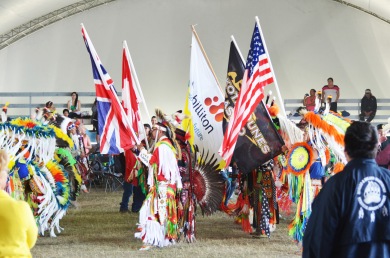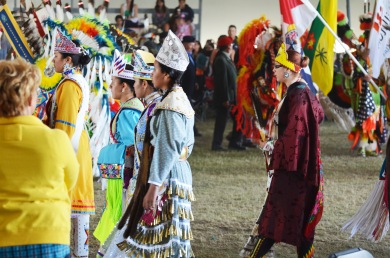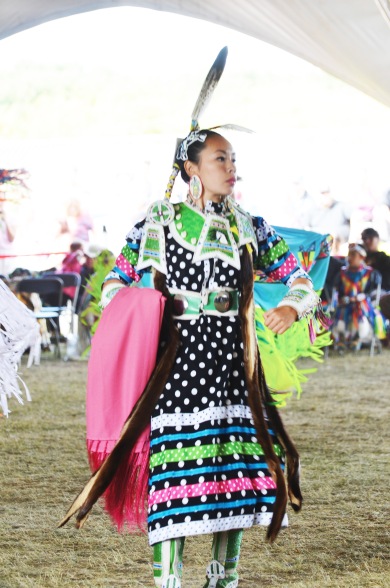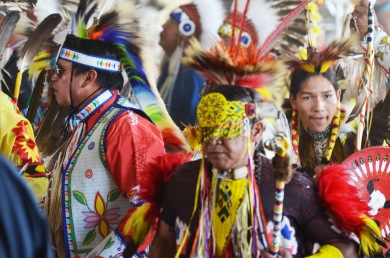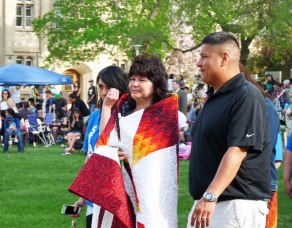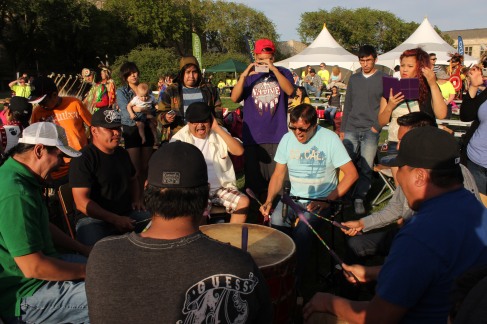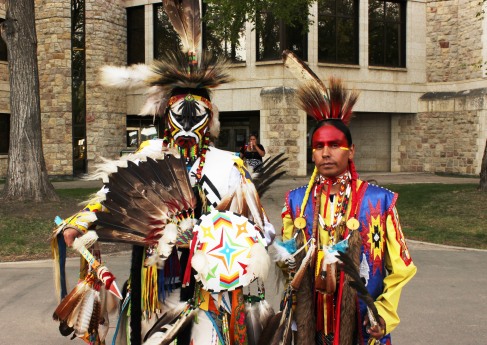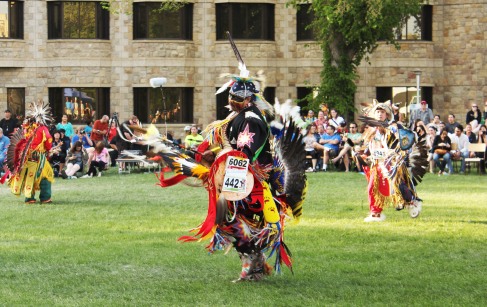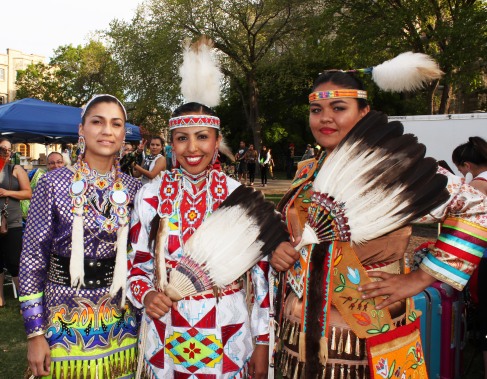We have moved to http://www.indigenoustimes.ca
Upcoming Spring Fever Cabaret Catches Attention of Independent Filmmaker
by Armand LaPlante for the Indigenous Times News
When the Standing family, under the promotional name Independent Dog Face, puts on a cabaret you know it’s going to be a good time. Their annual Spring Fever Cabaret this coming weekend (April 25 & 26) at Rock the Bottom Bar in Saskatoon will feature popular Saskatchewan band Black Rain, as well as many other musicians, and a fashion show with Aboriginal designers and models. “You can expect a good time,” says Curtis Standing, “this weekend too the FSIN Hockey Tournament is going on, so everybody is going to want to go out.”
Since Independent Dog Face began putting on shows and cabarets in Spring 2011, they have garnered a loyal following of music lovers and anyone looking to have a good time. These events have provided a platform for Aboriginal talent in the province of Saskatchewan.
The cabarets are known to have great original tunes playing all night keeping the party live, but the fashion show part is also important for Independent Dog Face as promoters. “[The fashion show] is going to be really good. The ladies are putting together their designs; it’s good for the designers as well as the models to get out there and get some exposure” says Curtis.
Independent Dog Face and the Spring Fever Cabaret have also partnered up with an independent filmmaker from Winnipeg – Aaron Peters. Peters, an award-winning musician and music enthusiast himself, will be on site filming the entire weekend to feature in his latest project.
The documentary, which will be Peters’ fourth film project, will feature interviews from the Standing family, as well as many others involved in the music scene from performers to venue owners. The documentary will highlight the local music scene and all that goes into putting on these events to help a music scene – and a community – flourish.
“[The Standing family] invests blood, sweat, and tears into promoting Aboriginal performers” says Peters. And with the inception of Youtube and other forms of downloading music, the music industry, according to Peters, has been more difficult than ever to succeed in: “musicians had an uphill battle before, but now it’s like they have to scale a skyscraper with their bare hands.”
“Everybody’s welcome, come on out, it’s going to be a good time,” says Curtis, “It’s always important to network, be out there socially, and just see what’s happening out there in the community. Come check out local Aboriginal talent and have a good time.”
Advanced tickets can be bought at the Vinyl Exchange or The Joint downtown for $10.
Black Rain (performing above) will be headlining the Spring Fever Cabaret
at Rock the Bottom Bar in Saskatoon, Friday April 25th & Saturday April 26th.
Dakota Dunes Casino 7th Annual Pow Wow 2013
Sask First Nation Summer Games Ready to Kick Off July 15 – 19
By Blue Pelletier
For Indigenous Times Newspaper
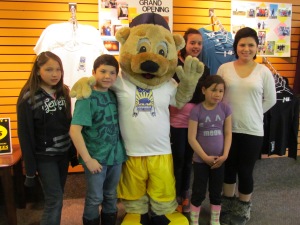
Sask First Nations Summer Games Mascot with some local athletes at a fundraiser for the games,
Muskoday First Nations. Submitted photo.
The Saskatchewan First Nation Summer Games will take place July 15-19. This year’s host community will be the Muskoday First Nation. It will mark the first time, since the 1993 North American Indigenous Games, that First Nations People have gathered in and around the Prince Albert area to participate in such an event.
Teams will come from all over Saskatchewan and will represent their home First Nation through their Tribal Councils. Each team will send down athletes to participate in six different sports (Athletics, Archery, Softball, Soccer, Golf and Canoeing) at various age divisions.
Fenton Favel is the Chef de Mission for Team Woodlands; he says “this year’s group of athletes will be the largest group ever that Team Woodlands has sent to a games, over 300 athletes.” Favel says that this group has high hopes and expectations heading into the games “You want to take 1st; we want to participate and make friends. It is our goal to move up in the standings. Last time we finished 5th overall.”
The games are a great opportunity for First Nation Youth from across the province to gather in a positive athletic environment, where culture and traditional teachings are prominent.
Marvin Sanderson is the Games Coordinator, he states that “Sports gives youth an avenue to gain self esteem. I am a prime example that sports can help you stay in school, build friendships and help you succeed in life. “
There are also many events prior to and during the games in which athletes, coaches, volunteers and attendees of the games can gather and enjoy.
The games will kick-off with the start of the BHPBilliton Lance Journey. The Lance Journey will start from the Thunderchild First Nation on July 9th and will arrive in Muskoday on July 15th to commemorate the beginning of the Games.
The SIGA opening ceremonies will take place Saturday July 16 at 5 pm at Art Hauser Centre. This event gives one the opportunity to pay tribute to the games organizers, athletes, and partners who helped bring the games together.
The Prince Albert Cultural Village will be located in the Kinsmen Park. There will be entertainment in the amphitheatre. A tipi village will be constructed in which traditional teaching will take place July 17 and 18 between 1pm-8pm.
The Closing Ceremonies are held on July 19th and will begin at 2:30pm or at the end of the Men’s Gold Medal Softball Game. It’s a chance to retire the flags and Lance for the next games. Also a time to honor the winner and participants of the games.
Sanderson hopes that the games will be a success and looks forward to the challenge “We are the home away from home for athletes, coaches, and visitors from all over the province. I want the athletes to take home friendships. To go home and further advance in the sports they participate in. And that these games will be a stepping stone to bigger events.”
Favel agrees, and says that “the games can be a springboard for a lot of athletes out there. These kids want to excel, they want to get better. When they get back they continue to train, they start to prepare again for the next games. They can go on to the Saskatchewan Summer Games, Westerns or even North American Indigenous Games.” •
Canada Day: Idle No More Round-dance in Saskatoon
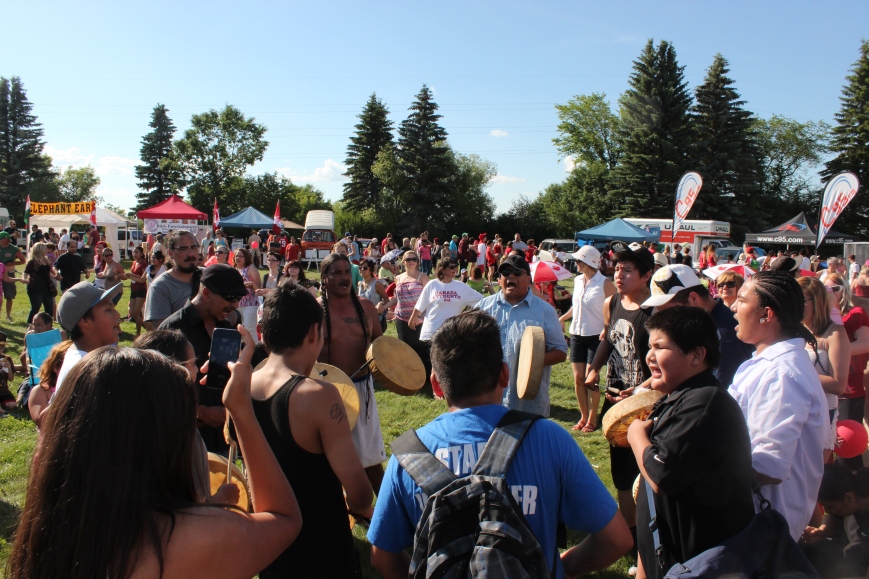
Canada Day Idle No More Demonstration. Idle No More flash round-dance at Diefenbaker Park, Saskatoon SK. July 1st 2013. Armand LaPlante Photo.
U of S Graduation Pow Wow 2013
Photos by Armand LaPlante (please email before use)
For Indigenous Times News
It was a beautiful day as thousands gathered at Saskatoon’s University of Saskatchewan for the annual U of S Graduation Pow Wow on May 29, 2013. The Pow Wow drew dancers, singers, and visitors from all over to celebrate Aboriginal high school and post-secondary graduates from across the province.
(click to enlarge)

Jared Brown was Honoured for graduating with Bachelor’s Degree and for being the first ever Aboriginal USSU President
***
Exclusive Interview: MC RedCloud of Los Angeles California
By Armand LaPlante
For Indigenous Times Newspaper
Mc RedCloud, Los Angeles CA. (photo by Armand LaPlante)
LOS ANGELES, CA – The setting is a loft in Los Angeles, California on a lively night in May. MC RedCloud and Crystle Lightning, the pair that make up eclectic, house, hiphop duo LightningCloud, are filming a new music video in front of a large green screen. The differing music styles of RedCloud and Crystle complement each other so well in this fresh new group; they have been referred to as the Red version of Bonnie & Clyde. During a short break at the video shoot I got to talk to MC RedCloud for a few minutes.
Armand: What is your video about that we’re shooting here right now?
RedCloud: It’s a fun song called Gravitron, me and Crystle [Lightning] wrote this track for the album. It’s a fire track and we always wanted to shoot a video for it and the homie Mitch Paulson came through with a cool, sick concept to do a green screen and make it look crispy. It’s just a really fun track, a lot of bright colours, a lot of fun.
Congratulations on winning Power 106’s “Who’s Next?” contest; that is huge! Tell us a little bit about that.
1600 artists in Los Angeles fought for the spot of “Who’s Next?” Battle of the Best and we beat everybody in LA. We then went on to beat the New York City winner, this cat named Radamiz, we took him out (in Austin Texas)– destroyed him. We won $10,000, 12 hours of studio time, and a beat from the producer Timbaland.
Timbaland is world famous. It must be an exciting time in your career.
It’s a dream come true. Working with Timbaland is going to be something that we really needed as break-thru artists and being brand new; this is the beginning of something beautiful. And what’s cool is that we get to work with Timbaland right now while he’s hot. He’s really hot right now with the new Justin Timberlake album that’s all over the world and topping the charts. Working with him right now is insane; we have the beat from him and we’re writing to it right now. It’s going to be amazing.
This past year you and Crystle Lightning came out with a new album called LightningCloud and it won best rap/hiphop album at the 2012 Aboriginal Peoples Choice Awards (APCMAs) in Winnipeg. The album had a new sound for you compared to your past work. What were you hoping listeners would sense when listening to the new album?
You know, people evolve, they move on, and they grow up. As a youngster I was a cold-blooded rapper – I still am – but as you get older your movements change and you grow up and mature. When I linked up with Crystle it was a mixture with her style which is a very electronic house vibe. It’s a marriage of two styles and that worked immediately and you see the results immediately. Stuff I couldn’t get done by myself for many years were done instantly with Crystle and Dj Hydroe on the scene.
This new LightningCloud is a whole new sound, a whole new movement, it’s really dope. And it won the best hiphop album of the year at the APCMAs ; that’s what set it off. We are super stoked; we didn’t think a little group from LA would be able to beat these groups that are from Winnipeg or from Canada. So it shows that the people speak.
How does being Aboriginal influence your music?
It’s always there, but people like me or like Joey Stylez who have found a pocket of success don’t necessarily have to cater our music specifically to Aboriginals. But being Aboriginal and being able to knock out some hits and being able to hang with the heavy hitters of other descents, that’s amazing. Being able to chart on top and having your people behind you, that’s automatic — always having your people rooting for you.
That’s what Crytsle and I are working on; like once you start kicking ass in LA you see that your people have your back no matter what. It goes to show no matter where you go that’s the key to success. Being Aboriginal means that you’re original, you’re the first copy and what we make is the first of everything. Natives out there shouldn’t be trying to pursue being the native version of 50 Cent or the native version of Eminem, or the Aboriginal version of Waka Flocka; we are the originators, we are the first people so everything we do needs to be the First, we need to bring it back to that, and we’ve got a good team over here doing that: 1491.
Got any words of advice for the urban and on-reserve youth grabbing microphones and trying to get in the rap game?
There’s no better time in the world than right now to follow your dreams and to chase them down. Right now the tallest basketball player is a Chinese guy, the sickest golfer is a black guy, and one of the sickest rappers is a white guy. If you’re Aboriginal, there is no better time in the world than right now to blow up because everyone is getting a piece right now.
So to my youth and to my natives, no matter where you are in the world right now ̶̶ in the middle of nowhere ̶̶ there are outlets, there are pockets for success, there are ways to get your music out and there are ways to follow your dreams. Don’t let anything that you are hold you back, that is no longer an excuse. It’s 2013. If you’re dope you’re dope! Period.
LightningCloud “Gravitron” video shoot, May 2013, Los Angeles California. L-R: Mitchell Paulson (videographer), RedCloud, Crystle Lightning, Joey Stylez. (photo by Armand LaPlante)
Traditional Values Guide Development
Organization Promises First Nation-led Economic Development with New SaskPower Agreement
MLTC Vice Chief Dwayne Lasas
BY LISA JOHNSON & JORDAN LAPLANTE
For the Indigenous Times Newspaper
Meadow Lake Tribal Council (MLTC) Vice-Chief Dwayne Lasas is feeling optimistic for the future. Recently, the Meadow Lake Tribal Council participated in an announcement of an agreement between the First Nations Power Authority and Sask Power. Regarding this initiative, Lasas has had no apprehensive of being a proponent and advocate for the First Nations Power Authority. The initiative is consistent with MLTC philosophy regarding Economic Resource Development, which is creating dividends and income for its nine member First Nations, yet respecting the environment.
Vice-Chief Dwayne Lasas is proud of the fact that they take into consideration traditional values in respect to the land – true sustainable development. MLTC companies are an example to other companies in resource development. Further, when it comes to resource development such as forestry, the approach here is much like that in the days of the reliance on the buffalo by our people. The people used all that the buffalo had to offer, from food to utensils, warm lodging, etc. NorSask forest products and Mistik management are doing the same with forestry. From lumber products to an energy source to keep our homes warm. On behalf of the present MLTC leadership, he acknowledges the forward thinking of previous leaders and those who established the MLTC companies.
An example of that, was the concerted effort to pay down their start-up loan debt, in which they did when the 2008 economic downturn happened. The companies were able to get through it somewhat unscathed.
In 2012, the present leadership wanted to continue looking forward. They insured that the companies were given the opportunity to prosper into the future by instituting best business practices through some reorganization, basically, separating business and politics.
He hopes that the power authority will always advocate for energy initiatives that are not detrimental to the environment and/or contribute in any significant way to global warming, This, he believes is consistent with the Tribal Council commitment to sustainable development, he then referred to Ben Voss.
With a new agreement with SaskPower, the First Nations Power Authority (FNPA) is inviting First Nations and industry to participate in a development projects that the FNPA says will put First Nations groups in the driver’s seat.
“It goes beyond the simple afterthought of consultation, and gives First Nations access,” says FNPA Chair Ben Voss, who hopes that “this becomes the model of how First Nations economic development can unfold.”
The FNPA is a non-profit organization mandated to connect SaskPower with First Nations groups who want to lead power projects.
In March, the FNPA announced a new ten-year master agreement with SaskPower worth $100,000 a year in operating costs for three years, but potentially generating hundreds of millions of dollars in long-term revenue.
The FNPA evolved out of the work of the Meadow Lake Tribal Council (MLTC) in 2010, which had been looking at building a power plant, and “ was in discussions with the government. So they asked us if we could come up with a plan and strategy for this initiative. It’s gone through lots of steps, but the idea is that we want First Nations to have a much more meaningful role in the development of these projects, and we want First Nations to keep the benefits of these projects. By doing it this way, it keeps First Nations in control, while allowing them to negotiate with the private sector,” explains FNPA Chair Ben Voss.
While the former process involved gaining government approval and then engaging First Nations in discussion, the FNPA’s agreement with SaskPower defines a pathway for launching independent First Nations power generation opportunities first, and then seeking partnerships with and proposals from industry.
In FNPA’s case, that means First Nations would develop and organize projects while retaining the licence to build, own, and receive revenues. The difference is big for First Nations and a private sector hungry for access to lucrative projects.
“Take the Northern Gateway project, which is highly controversial. What if the government had said to B.C. First Nations groups, ‘we want to build a pipeline that is important for Canada’s economy, and we’ll give you the right to organize and own it.’ Then, First Nations groups could approach Enbridge, for example, and say ‘we own it, but you have the industry expertise, so let’s build it together.’ That’s true economic participation; they aren’t going to oppose it,” says Voss.
The largest project ever undertaken by the MLTC, the Meadow Lake Bioenergy Centre, offers a perfect example of success, says Voss. The Centre will use bark, branches, sawdust, and wood chips from the NorSask Forest Products sawmill to generate up to 36 megawatts of renewable low-emissions power, which is enough to power roughly 30,000 homes.
“That’s huge. It’s a $150-million dollar project, with lots of positive impacts that add value to the forest economy and adds jobs to the community,” says Voss.
Other projects could utilize solar power, small wind power, or hydro-electric.
“We’re hoping that SaskPower gets more comfortable with these projects, [and] they’ll want to take on bigger projects with us. There are lots of different technologies that are important to reliable, sustainable energy in the province,” says Voss.
Aboriginal Affairs and Northern Development Canada (AANDC) provided $1.39M worth of funding through their Strategic Partnership Initiative program, Community Economic Opportunities Program and Community Support Services Program. •


